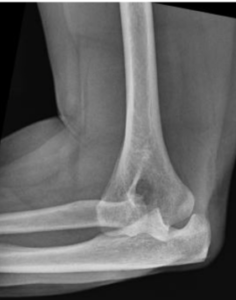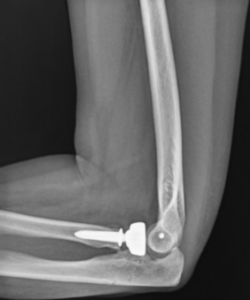Elbow Dislocations
What is an Elbow Dislocation?
An elbow dislocation is when the ulna forearm bone dislocates from the humerus bone. This can be due to ligament injury, fractures or both.
What Causes an Elbow Dislocation?
Elbow dislocation can result from high energy injuries such as car accidents or motorcycle crashes or from falls on an outstretched hand.
How is an Elbow Dislocation Diagnosed?
Often elbow dislocations can be diagnosed on physical exam. Obviously, it is important to determine whether an injury to the nerves or vessels has occurred. It is also important to determine whether it is an open injury, meaning the bone is exposed through the skin as this requires more urgent treatment and antibiotics to help prevent infection.

Preoperative x-ray of elbow dislocation fracture.
Elbow Dislocation Treatment
The treatment for elbow dislocations depends on the ultimate stability of the elbow after it is put back in place. Simple elbow dislocations are when the elbow dislocates but the bones are not broken. This is often due to ligament stretch or tear. These often can be treated with a reduction in the emergency room and a splint or brace without surgery. When the bones are broken and the elbow remains unstable after reduction, surgery is often required.
Non-Surgical Treatment for Elbow Dislocation
If non-operative care is chosen, regular follow-up care for a physical exam and x-rays is important to ensure that the elbow stays in good position and heals appropriately.
Surgical Treatment for Elbow Dislocation
The type of elbow dislocation surgery depends on the specific bones or ligaments that are injured. Each bone and fracture type can be treated with several different treatment options. These surgeries can be combined when multiple bones are broken at the same time.
Usually, the incision for elbow dislocation surgery is made on the outside part of the elbow. Depending on what is injured the surgeon may repair the front part of the elbow through this incision as well as the radial head and the lateral ligament that provides stability to the elbow. In some situations, the radial head bone is broken into many pieces and a radial head “replacement” is performed. If this is the case, a metal implant is used to replace the broken head of the radius. This is similar to a knee or hip replacement.
It is important to choose your surgeon wisely. Extensive surgical experience can be helpful in achieving a good result and avoiding complications. Collectively, ROC orthopedic surgeons have performed more elbow dislocation operations than any practice in northern Nevada and take pride in outstanding surgical results.
After surgery, patients are often given a splint or a brace. Gentle motion is begun early to prevent stiffness. Gradually this motion is increased, and physical therapy is begun around 3-6 weeks after surgery. Elbow fracture injuries tend to develop significant stiffness and long-term therapy is needed to regain good motion and strength.

Postoperative x-ray of elbow dislocation fracture repair.
Complications After Elbow Dislocation Surgery
Complications can occur following elbow surgery. There is always a risk of infection with any surgery, no matter how small. A dose of antibiotics given prior to surgery helps to make this risk as small as possible. There is always a risk of injury to blood vessels or nerves. This is reduced by having an experienced surgeon involved in your care. Noncompliance with weight bearing restrictions, too much motion or falls can result in the metal ripping out of the bone or the fracture separating. It is always possible that the bone may not heal, and additional surgery will be required. This is usually associated with patient noncompliance, diabetes, or use of nicotine like smoking and chewing tobacco.
How Long Does It Take to Recover from Elbow Dislocation Surgery?
Most people with elbow fractures do very well and return to prior activities and function. The bone and ligaments usually take 3-4 months to heal completely. Aggressive return to activity too early can result in re-fracture, hardware breakage or nonunion. Even when the bones are lined up and heal perfectly some residual elbow stiffness is common. Sometimes metal around the elbow becomes prominent or painful. It can be removed a year after the initial surgery.
In need of an orthopedic specialist? Schedule an appointment with one of our specialty-trained Trauma and Fracture doctors to talk through your options. Reno Orthopedic Center offers comprehensive treatment for a full range of traumatic injuries at multiple convenient locations in Reno, Sparks and Carson City.
